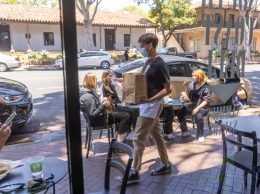COVID-19 restrictions that canceled events and shuttered restaurants have collapsed distribution chains for fresh fruit, vegetables and flowers grown throughout the Tri-Counties.
Consumer demand plunged, growers said, as buyers prioritized shelf-stable goods like grains, pasta and frozen and canned foods, foregoing berries, leafy greens and cut flowers grown on the Central Coast.
“(Agriculture is) an essential industry, but almost all of the markets went away overnight,” said John Krist, CEO of the Ventura County Farm Bureau. “The price out there is too low to justify picking.”
As berry season gets underway, the steep decline in demand from food service and restaurant customers has also put pressure on lemon and avocado growers that rely on those outlets. Export markets saw the first declines at the start of the year, followed by event cancellations, restaurant closures and finally grocery stores, where customer habits have changed. And while some restaurants and catering companies have reopened for takeout or delivery, volumes are still low.
“It’s all such a delicate balance between supply and demand and timing,” Krist said. “We produce such prodigious volumes … there’s an awful lot of food looking for a home.”
For Oxnard vegetable grower Deardorff Family Farms, fields of celery, cilantro and leafy greens are planned in such a way that there’s always product available.
With orders from food service customers down 90 percent or more, that’s meant skipping over entire fields when they reach maturity, said co-owner Scott Deardorff.
“When the food service industry collapses, that takes a lot of production that would normally go there and tries to put it into the retail market,” Deardorff said. “The market’s so low it doesn’t pay to get it out of the field. Once that field is disced under, it’s a cost you can never recover.”
Those losses aren’t covered under standard crop insurance, he added.
“We looked through our policies, and there’s no coverage there.”
Another top crop for the region, cut flowers, is also contending with a steep drop in demand, as retail stores and wholesale florists have been forced to shut down due to statewide restrictions. Studio designers that supply flowers for weddings, banquets, conventions and other events have also closed their doors.
“Since all this took place, there have been so many aspects of our distribution chain that have collapsed,” said Dave Pruitt, interim CEO of the California Cut Flower Commission.
While some businesses have maintained delivery services, without their usual high volumes, trucking lines disappeared, with no routes available to ship products to the East Coast for weeks.
“Most of my growers, they’re between 15-20 percent of normal business,” Pruitt said. “A lot of that has needed to be plowed under or harvested and thrown away,” including some San Luis Obispo County growers that discarded between 100,000 and 250,000 stems per week.
One community event at Avila Valley Barn April 2 handed out around 30,000 flowers to the community for free.
Food growers are also giving away as much as possible through partnerships with food banks like Food Share in Ventura County, Deardorff said, which have seen demand increase as workers and students stay home.
Some types of produce like avocados can be “stored” on the tree or vine for a time, and some growers with perennial flowers can keep them alive until demand returns. But many flower growers in the 805 region have gone into “hibernation,” Pruitt said, until the restrictions lift.
Upcoming holidays like Easter and Mother’s Day, which usually account for around a third of the cut flower industry’s annual sales, represent a potential bright spot on the horizon. But “It’s difficult for them to find out how long they can actually keep doing that,” Pruitt said. “The bright spot would need to be really bright to try and save what’s happened.”
In the meantime, that means significant declines in jobs throughout the industry, he added. “Everybody has laid off a portion of their crew.”
Deardorff Family Farms has been able to retain its workforce, but everyone has had to take cuts to their hours, depending on if there’s a market for the produce that day.
For those workers that have stayed, safety procedures are built into the supply chain, growers said, from face protection that is standard for dust and pollen to handwashing stations. Companies have enforced distance between workers and conducted increased training for employees in sanitation and food safety.
“That’s been second nature for us for quite a while in the fresh vegetable industry,” Deardorff said.
Agriculture and food service workers are a “second line” of responders during the crisis, he added.
“Those people are still working, selling food, processing food or growing food,” Deardorff said. “They’re a second line of people backstopping and trying to keep people healthy. We’re an essential business, so we’re working, but it doesn’t seem like people are buying.”
• Contact Marissa Nall at mnall@pacbiztimes.com.






 Print
Print Email
Email

















